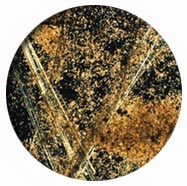 Grunerite is the mineralogically correct name used for amphiboles of the cummingtonite-grunerite series in which iron is predominant over magnesium (70% or more Fe / [Fe+Mg]). The commercial asbestiform product used in building materials, commonly known as "amosite" (from the "Asbestos mines of South Africa") should thus be characterized as asbestiform grunerite. Grunerite is the mineralogically correct name used for amphiboles of the cummingtonite-grunerite series in which iron is predominant over magnesium (70% or more Fe / [Fe+Mg]). The commercial asbestiform product used in building materials, commonly known as "amosite" (from the "Asbestos mines of South Africa") should thus be characterized as asbestiform grunerite.
Crystals of grunerite range in morphology from relatively thick, flat prisms to acicular, brittle grains, to very long, thin fibers and fiber bundles. The long thin fibers are moderately brittle and often bend in wide arches. Bundles of grunerite tend to separate into smaller groups of needlelike fibers. Because grunerite fibers do not normally fray or have split ends, but rather have flat or knifelike ends, the needlelike morphology may help to distinguish this amphibole from chrysotile. Forms of bundles resembling "broom tails" are also common. Small thin fragments of the mineral are common in some building materials.
Grunerite is monoclinic and typically weakly colored in green or brown in plane light. The magnesium-rich end member of the cummingtonite-grunerite series is colorless and non-pleochroic, but the pleochroism increases with Fe/ Mg ratio. Iron-rich grunerite fibers may have colors ranging from very pale yellow to light brown. Whereas non-fibrous grunerite is monoclinic, grunerite fibers commonly show parallel extinction, although it is not uncommon to find extinction angles of up to 20°. The parallel extinction is attributed to the overall increase in symmetry, caused by the random crystallographic orientation of individual fibrils normal to the fiber axes.
The refractive indices of the cummingtonite-grunerite series range from 1.635 to 1.729, depending on composition and orientation of the optical axes. Indices near 1.680 are most common. Under plane light, a typical grunerite fiber mounted in a R.I. liquid of 1.680 is faint (or not visible at all if very thin). The colors of the Becke lines should be evident in the matching oil. Under crossed polars grunerite is readily recognizable. The moderate to high birefringence makes the bright grunerite fibers stand out sharply against the dark background; this may lead to the overestimation of amosite percentages in a sample. The birefringence of grunerite ranges from 0.020 to 0.045.
Amosite exposed to high temperatures for a long period of time is referred to as heated amosite and may differ in color and morphology from normal amosite. The color of heated amosite, typically ranges from a pale yellow to a reddish-brown color in plane light. This type of amphibole is relatively short and brittle

Amosite as seen under polarized light

Chrysotile and Amosite fibers as seen under polarized light
|